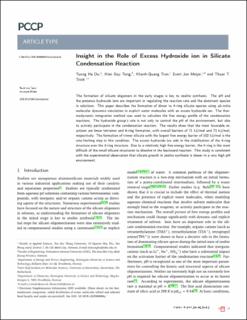| dc.contributor.author | Do, Tuong Ha | |
| dc.contributor.author | Tong, Hien Duy | |
| dc.contributor.author | Tran, Khanh-Quang | |
| dc.contributor.author | Meijer, Evert Jan | |
| dc.contributor.author | Trinh, Thuat | |
| dc.date.accessioned | 2024-01-18T07:48:13Z | |
| dc.date.available | 2024-01-18T07:48:13Z | |
| dc.date.created | 2023-05-26T13:56:03Z | |
| dc.date.issued | 2023 | |
| dc.identifier.citation | Physical Chemistry, Chemical Physics - PCCP. 2023, . | en_US |
| dc.identifier.issn | 1463-9076 | |
| dc.identifier.uri | https://hdl.handle.net/11250/3112333 | |
| dc.description.abstract | The formation of silicate oligomers in the early stages is key to zeolite synthesis. The pH and the presence of hydroxide ions are important in regulating the reaction rate and the dominant species in solutions. This paper describes the formation of silicate species, from dimers to 4-membered rings, using ab initio molecular dynamics simulations in explicit water molecules with an excess hydroxide ion. The thermodynamic integration method was used to calculate the free energy profile of the condensation reactions. The hydroxide group's role is not only to control the pH of the environment, but also to actively participate in the condensation reaction. The results show that the most favorable reactions are linear-tetramer and 4-membered-ring formation, with overall barriers of 71 kJ mol−1 and 73 kJ mol−1, respectively. The formation of trimeric silicate, with the largest free-energy barrier of 102 kJ mol−1, is the rate-limiting step under these conditions. The excess hydroxide ion aids in the stabilization of the 4-membered-ring structure over the 3-membered-ring structure. Due to a relatively high free-energy barrier, the 4-membered ring is the most difficult of the small silicate structures to dissolve in the backward reaction. This study is consistent with the experimental observation that silicate growth in zeolite synthesis is slower in a very-high-pH environment. | en_US |
| dc.language.iso | eng | en_US |
| dc.publisher | Royal Society of Chemistry | en_US |
| dc.rights | Navngivelse 4.0 Internasjonal | * |
| dc.rights.uri | http://creativecommons.org/licenses/by/4.0/deed.no | * |
| dc.title | Insight into the role of excess hydroxide ions in silicate condensation reactions | en_US |
| dc.title.alternative | Insight into the role of excess hydroxide ions in silicate condensation reactions | en_US |
| dc.type | Peer reviewed | en_US |
| dc.type | Journal article | en_US |
| dc.description.version | acceptedVersion | en_US |
| dc.source.pagenumber | 0 | en_US |
| dc.source.journal | Physical Chemistry, Chemical Physics - PCCP | en_US |
| dc.identifier.doi | 10.1039/d3cp00475a | |
| dc.identifier.cristin | 2149623 | |
| dc.relation.project | Norges forskningsråd: 262644 | en_US |
| cristin.ispublished | true | |
| cristin.fulltext | postprint | |
| cristin.qualitycode | 2 | |

